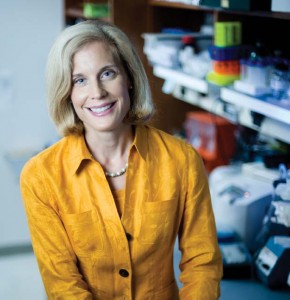An Exciting Time
May 21, 2014

Photo by Joe Howell
We know that half of all cancer cases are preventable or detectable early, and imaging plays a big role in early detection of tumors. For example, our new lung cancer screening program, just launched in January, provides low-dose CT scans for patients at high risk for lung cancer, one of the deadliest cancers. Ninety percent of Stage I lung cancer is curable, but it is usually not detected until an advanced stage when few treatment options are successful. We know that if patients stop smoking and get regular screenings, we can make a significant difference in lung cancer.
But there still remains the half of cancers we cannot prevent or detect early. For those patients, we must be ready with treatments, and that’s where our new Center for Cancer Targeted Therapies (CCTT) is ready to take action. The CCTT leverages our expertise in personalized medicine by matching the genetic sequence of a patient’s tumor with a targeted therapy or clinical trial. We’re having tremendous success at giving those individuals a cure or remission and getting them back to life.
Some of the speed and success in drug therapies can be attributed to the rapid pace of approvals of new drug applications by the Food and Drug Administration. From September 2012 to August 2013, the FDA approved 11 new drugs to treat a variety of cancers, three new uses for previously approved anticancer drugs, and three new imaging technologies. The National Cancer Institute is also completing an eight-year project called The Cancer Genome Atlas, in which they have genetically sequenced over 10,000 tumors and made the data publically available. Researchers around the world are leveraging that database to make fundamental cancer research findings and translate those discoveries into new drug targets and therapies. And it reinforces the idea that to really make a difference in cancer, we must share our knowledge and work together.
The Southeast has the highest cancer death rates in the U.S., and many cases could be prevented through lifestyle changes involving cessation of tobacco use, modifications in diet and increased physical activity. Prevention is better than cure, but despite our best efforts to encourage a healthier lifestyle, malignant diseases will continue to be common and need treatment for many years to come. I take heart in the fact that we are well positioned to provide the breadth and depth of cancer prevention, treatment and control to the community. Through the power of research discoveries, we are enabling prevention strategies, finding innovative ways to detect cancer earlier, and developing and implementing personalized therapies. All of this discovery and translation is occurring at a rate we never previously dreamed possible. We are at an exciting time with many major advances on the horizon.
Sincerely,
Jennifer Pietenpol
